
R-Type is a horizontally scrolling shooter arcade video game developed and released by Irem in 1987 and the first game in the R-Type series. The player controls a star ship, the R-9 "Arrowhead", in its efforts to destroy the Bydo, a powerful alien race bent on wiping out all of mankind. The R-9 can acquire a glowing orbicular device called a "Force", protecting it from enemy fire and providing additional firepower. The arcade version was distributed by Nintendo in North America; it is the last arcade title Nintendo distributed.

The ZX Spectrum is an 8-bit home computer developed and marketed by Sinclair Research. It is one of the most influential computers ever made, and it is also one of the best selling computers ever, with over five million units sold. It was first released in the United Kingdom on 23 April 1982, and around the world in the following years, most notably in Europe, the United States, and Eastern Bloc countries.

Rainbow Islands: The Story of Bubble Bobble 2 (レインボーアイランド) is a 1987 arcade video game developed and published by Taito, with the arcade version licensed to Romstar for North American manufacturing and distribution. The game is the sequel to Bubble Bobble from the previous year, and it is the second of four arcade games in the series. The game was ported to home computers and home video game consoles.

Out Run is an arcade driving video game released by Sega in September 1986. It is known for its pioneering hardware and graphics, nonlinear gameplay, a selectable soundtrack with music composed by Hiroshi Kawaguchi, and the hydraulic motion simulator deluxe arcade cabinet. The goal is to avoid traffic and reach one of five destinations.

Your Sinclair, or YS as it was commonly abbreviated, was a commercially published and printed British computer magazine for the Sinclair range of computers, mainly the ZX Spectrum. It was in circulation between 1984 and 1993.

Operation Wolf is a light gun shooter arcade game developed by Taito and released in 1987. It was ported to many home systems.

Crash, stylized as CRASH, is a magazine dedicated to the ZX Spectrum home computer, primarily focused on games. It was published from 1984 to 1991 by Newsfield Publications Ltd until their liquidation, and then until 1992 by Europress. It was relaunched as a quarterly A5 magazine in December 2020 with the backing of the original founders.
1987 saw many sequels and prequels in video games, such as Castlevania II: Simon's Quest, Dragon Quest II, Final Lap, and Zelda II, along with new titles such as After Burner, Contra, Double Dragon, Final Fantasy, Mega Man, Metal Gear, Operation Wolf, Phantasy Star, Shinobi, Street Fighter and The Last Ninja. The Legend of Zelda was also introduced outside of Japan.
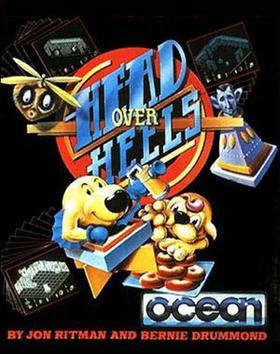
Head Over Heels is an action-adventure video game released by Ocean Software in 1987 for several 8-bit home computers. It uses an isometric engine that is similar to the Filmation technique first developed by Ultimate Play the Game.
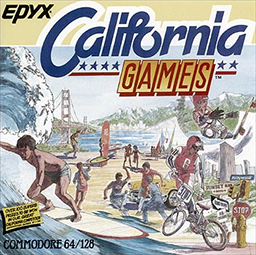
California Games is a 1987 sports video game originally released by Epyx for the Apple II and Commodore 64, and ported to other home computers and video game consoles. Branching from their Summer Games and Winter Games series, this game consists of a collection of outdoor sports purportedly popular in California. The game was successful and spawned a sequel, California Games II.
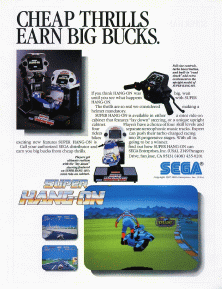
Super Hang-On is a motorcycle racing arcade video game released by Sega as the sequel to Hang-On. It uses a simulated motorcycle arcade cabinet, like the original game. An updated version was released in arcades 1991 as Limited Edition Hang-On.
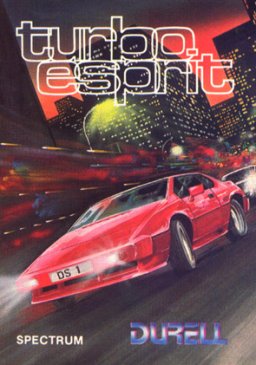
Turbo Esprit is a video game published by Durell Software in 1986 for the ZX Spectrum, Commodore 64, and Amstrad CPC. The game was very detailed and advanced for its time, featuring car indicator lights, pedestrians, traffic lights, and a view of the car's interior controls. Turbo Esprit was the first free-roaming driving game, and has been cited as a major influence on the later Grand Theft Auto series.
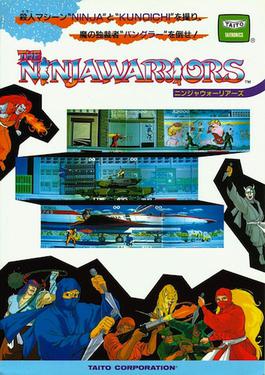
The Ninja Warriors (ニンジャウォーリアーズ) is a side-scrolling beat 'em up video game developed and released by Taito in 1987. The original arcade game situated one display in between projected images of two other displays, creating the appearance of a triple-wide screen. Ports were released for home systems including the Amiga, Atari ST, ZX Spectrum, Commodore 64, Amstrad CPC, PC Engine, and Sega Mega-CD.

GP Rider is a motorcycle racing game developed and manufactured by Sega, released in as an arcade video game in Japan, North America and Europe. It came in a two-player motion simulator cabinet and a standard upright cabinet. It was ported to the Master System in 1993 and then Game Gear in 1994.

Enduro Racer (エンデューロレーサー) is an arcade racing game from Sega. It was released in 1986 with two arcade cabinet versions, a stand-up cabinet with handlebars and a full-sized dirt bike cabinet. It is often seen as a dirt racing version of Hang-On, as it uses a similar engine and PCB. The game was later released for the Master System in 1987, the ZX Spectrum and Commodore 64 in 1988, and the Amstrad CPC and Atari ST in 1989.
Faster Than Light (FTL) was a software publishing label established by UK video game publisher Gargoyle Games. The aim was for FTL to publish arcade-style games, while Gargoyle would concentrate on its core business of adventure games.

RoboCop is a beat 'em up / run and gun video game developed and published by Data East for arcades in 1988 based on the 1987 film of the same name. It was sub-licensed to Data East by Ocean Software, who obtained the rights from Orion Pictures at the script stage. Data East and Ocean Software subsequently adapted the arcade game for home computers.

WEC Le Mans, known as WEC Le Mans 24 in Japan, is a racing simulation video game released in arcades by Konami in 1986. It was the first racing video game to depict the 24 Hours of Le Mans World Endurance Championship (WEC). The Lap of Le Mans is split up into three sections, during which the time of day changes from day to dusk, dusk to night, and night to dawn.

Leader Board is a series of golf simulation video games that was developed by Bruce Carver and Roger Carver, and published by Access Software.

Knight Rider is a 1986 video game based on the series of the same name. It was developed and published by Ocean Software, and was released in Europe for Amstrad CPC, Commodore 64, and ZX Spectrum.


















